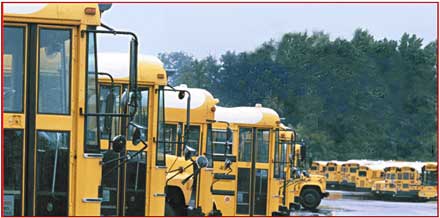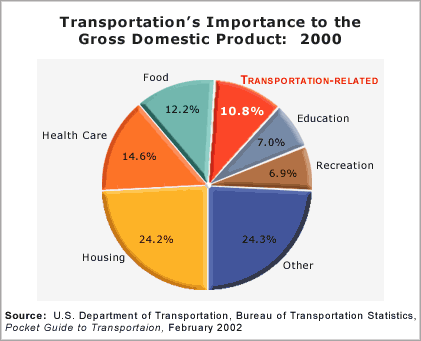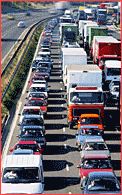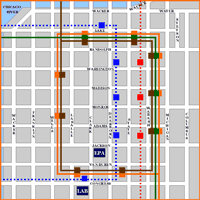

Scope of the American Transportation System
America's transportation network is an important tie binding our economy
together. Our strong and efficient transportation system provides businesses
with access to materials and markets, and provides people with access
to goods, services, recreation, jobs, and other people. Transportation
touches each one of us every day in all aspects of our lives. One in eight
jobs throughout the economy is directly linked to transportation. Each
day, about 440,000 public school buses transport 24 million children to
and from school and school-related activities.

Transportation contributes 11 percent of the Nation's gross domestic product, amounting to approximately $950 billion. Transportation accounts for 19 percent of spending by the average household in America - as much as for food and health care combined - and is second only to spending on housing.
The U.S. transportation system carries over 4.7 trillion passenger miles of travel and 3.7 trillion ton miles of domestic freight generated by about 270 million people, 6.7 million business establishments, and 88,000 units of government. Rail and maritime transportation each account for over 11 percent of the tonnage carried.

The system comprises of 3.9 million miles of public roads and 2 million
miles of oil and natural gas pipelines. There are networks consisting
of 120,000 miles of major railroads, over 25,000 miles of commercially
navigable waterways, and over 5,000 public-use airports. This vast system
also includes over 500 major urban public transit operators and more than
300 ports on the coasts, Great Lakes, and inland waterways.
In 1999, the system carried 2.7 trillion miles of travel by cars and trucks, more than 9 billion trips on public transit, more than 640 million passenger boardings on airplanes, 21 million trips on Amtrak, and nearly 700 million rail freight train miles.
Transportation is a strategic investment that is essential to strengthening America for the fresh challenges and limitless opportunities of the 21st century. America will need an integrated transportation system in the future that moves people, goods, information, and services safely and efficiently.
American Modes of Travel
The U.S. transportation system includes the various modes of travel: highways,
transit, rail, air, and water. Following are brief descriptions of each.
Highway System
The United States highway network consists of 4 million miles of roads
and streets.  Highway
bridges also make up a critical link in the
Nation's infrastructure. At present,there are about 600,000 bridges on
the entire highway network. State and local governments control most roads
and bridges in the United States, but all highways serve as part of an
integrated national network.
Highway
bridges also make up a critical link in the
Nation's infrastructure. At present,there are about 600,000 bridges on
the entire highway network. State and local governments control most roads
and bridges in the United States, but all highways serve as part of an
integrated national network.
The Interstate Highway System accounts for only 1 percent of all highway mileage but carries 25 percent of the total vehicle miles of travel. With the completion of the Interstate System in the 1980s, the focus shifted toward maintaining and improving the system, improving traffic flow, and upgrading connections with other modes of transportation.
Transit (Public Transportation)
The U.S. transit system includes a variety of multiple-occupancy vehicle
services designed to transport  customers
on local and regional routes. These services are operated by more than
5,000 public transportation systems throughout the United States and include
rail, road, and water modes. Currently, the public transportation fleet
comprises 129,000 vehicles in active service, of which 58 percent are
buses, 26 percent are demand-responsive vehicles, 8 percent are heavy
rail cars, 4 percent are commuter rail cars, 1 percent are light rail
cars, and 3 percent are all other transportation modes. In 1998, Americans
made 8.7 billion passenger trips on public transportation, with 61 percent
of the trips on buses, 27 percent on heavy rail, and 8 percent on commuter
and light rail.
customers
on local and regional routes. These services are operated by more than
5,000 public transportation systems throughout the United States and include
rail, road, and water modes. Currently, the public transportation fleet
comprises 129,000 vehicles in active service, of which 58 percent are
buses, 26 percent are demand-responsive vehicles, 8 percent are heavy
rail cars, 4 percent are commuter rail cars, 1 percent are light rail
cars, and 3 percent are all other transportation modes. In 1998, Americans
made 8.7 billion passenger trips on public transportation, with 61 percent
of the trips on buses, 27 percent on heavy rail, and 8 percent on commuter
and light rail.
Passenger Railroads
 The
advent of relatively inexpensive air travel in long-distance markets and
the widespread availability of the private automobile for shorter trips
generated new travel patterns and drew passengers away from railroad travel.
Following nearly a century and a half of intercity passenger operations
by private freight railroads, the Rail Passenger Service Act of 1970 established
The National Railroad Passenger Corporation (popularly known as Amtrak).
Since its founding, Amtrak rebuilt rail equipment and benefited from significant
public investment in track and stations, particularly in the Northeast
Corridor.
The
advent of relatively inexpensive air travel in long-distance markets and
the widespread availability of the private automobile for shorter trips
generated new travel patterns and drew passengers away from railroad travel.
Following nearly a century and a half of intercity passenger operations
by private freight railroads, the Rail Passenger Service Act of 1970 established
The National Railroad Passenger Corporation (popularly known as Amtrak).
Since its founding, Amtrak rebuilt rail equipment and benefited from significant
public investment in track and stations, particularly in the Northeast
Corridor.
Aviation
 Air
travel is the fastest growing mode of transportation, becoming ever more
popular and frequent. The growing pervasiveness of air travel can be seen
by the increasing numbers of people who have flown on a commercial jet:
less than 50 percent in 1975 compared with more than 80 percent today.
Air
travel is the fastest growing mode of transportation, becoming ever more
popular and frequent. The growing pervasiveness of air travel can be seen
by the increasing numbers of people who have flown on a commercial jet:
less than 50 percent in 1975 compared with more than 80 percent today.
Maritime Shipping
Maritime shipping has generally been intermodal; other forms of transportation
are needed to haul cargo to and from ports. The U.S. maritime transportation
system consists of waterways, ports and their connections to other transportation
modes, vessels, vehicles, and system users.
| Map Maker |
| Airports |
| Parkways and Scenic Rivers |
| Railroads |
| Roads |
| Map Layers |
| Airports |
| Parkways and Scenic Rivers |
| Railroads |
| Roads |
| Printable Maps |
| Reference and Outline Maps of the United States |
| Wall Maps |
| General Reference Maps |
| Articles |
| Amtrak Facts |
| Federal-Aid Highway Act of 1956 |
| Overview of U.S. Freight Railroads |

